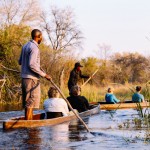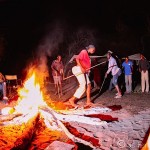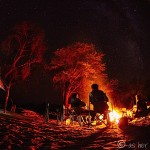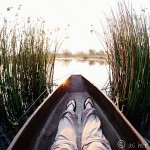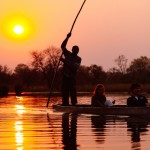Can I tell you how excited I am to share these next few posts? I LOVED this part of my African travels.
The Okavango Delta in northern Botswana consists of permanent marshland and seasonally flooded plains. Here’s how the cycle works: there is a month-long rainy season around January-February. It takes about four months (March-June) for that accumulation to spread over the entire Delta. Flooding peaks in June-August at which point the delta is THREE TIMES its normal size. Due to high temperatures that water evaporates over the next few months (September-December). The cycle begins all over again in the new year.
Here’s what the Okavango Delta looks like from space:
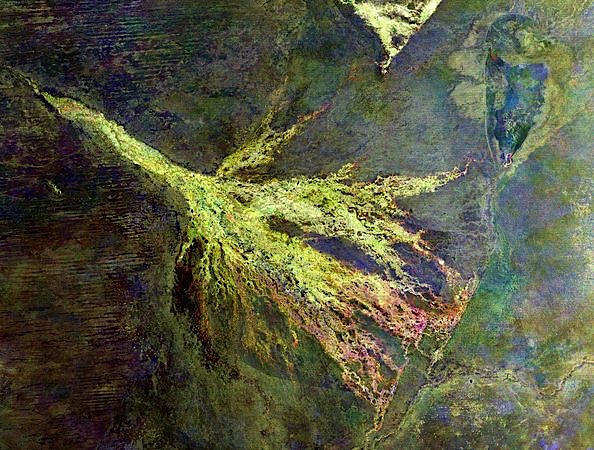
[image via]
And here’s a map of the area — I’ve put a red box around the city of Maun, which is the primary jumping off point for Okavango Delta tours. See the faint green line around Moremi Game Reserve? That’s the area where you’ll find the highest concentration of wildlife. And I’ve used the two asterisks to point out the general locations our tour visits — travelers who have paid for an accommodated package will fly from Maun to their luxury camp near the BLUE asterisk, and those of us who signed up for the camping package will drive and then canoe to our bush camp near the RED asterisk. As you can see, by springing for the luxury camp you’ll access a deeper part of the Delta and likely see more wildlife. I’m part of the bush camp group and we’ll stay on the outskirts of the Delta, but it still proves to be an exceptional experience during our three days / two nights in the area.
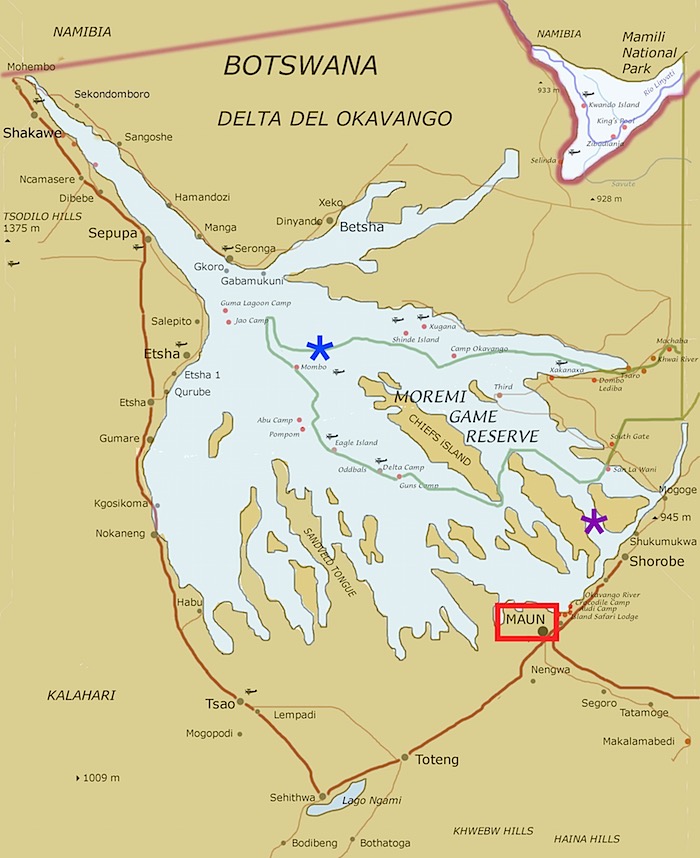
[image via]
Regardless of which area you visit, all Okavango Delta experiences will look like the photo below — navigating the flooded plains in mekoros (dugout canoes) while a poler stands at the back of the vessel using a long wooden pole to propel the boat forward:

Okay, now let’s back up to our arrival in Maun. I stock up on essentials at a rest stop: Hunter’s Gold cider, Sprite, and a Magnum espresso bar (coffee ice cream dipped in chocolate).

We pull over to admire these baobab trees.
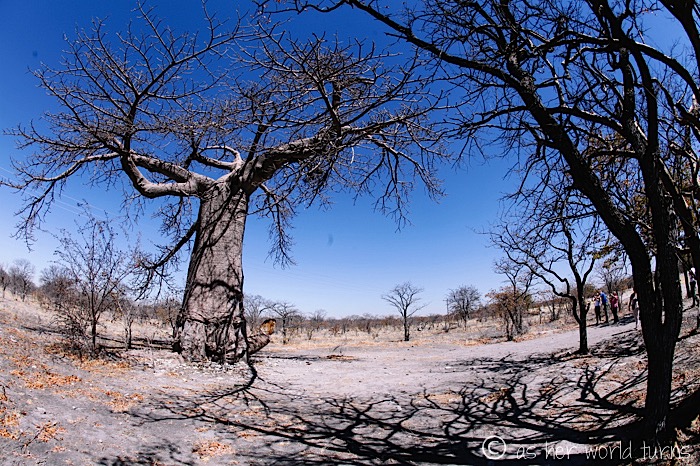
Our guide points out that this is, ahem, a male tree.

I’m amazed at just how flat the land is in Botswana. Side note about the Okavango Delta: it’s exceptionally flat, with less than two meters [6 feet] variation in height across 15,000 square meters.

We spot vultures hanging out in a big group, which can only mean one thing…
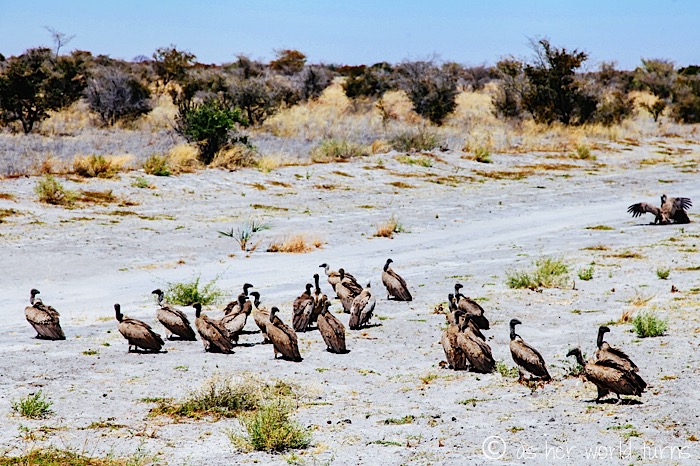
… there’s a carcass nearby. It’s this poor guy below, a (former) member of the cattle herds that wander this area. Interesting side note: farmers let their animals roam free and are unconcerned about them going missing or a neighbor poaching them. So guess what that translates to? It’s super dangerous to drive in Botswana at night because odds are decent you might run into a donkey or cow crossing the road. For kicks and giggles, check out this report questioning if Google Maps ran over a donkey in Botswana while capturing street view angles.

Approaching Maun we notice plumes of smoke; as we get closer it appears that a controlled burn has gotten out of hand, coming way too close to the main road and even scorching a car in the distance. Whoops…
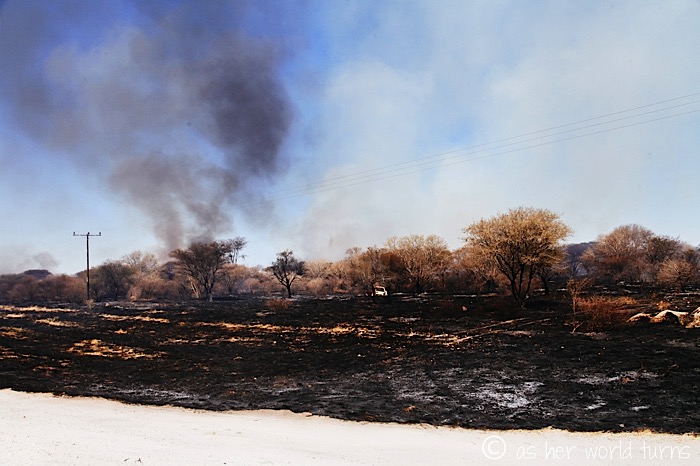
Upon arrival at camp, we’re instructed to pare our belongings down into a bag or two for the Okavango Delta (the rest of our stuff will be locked up on the bus in our individual storage lockers). Klaus shows off his Delta gear:
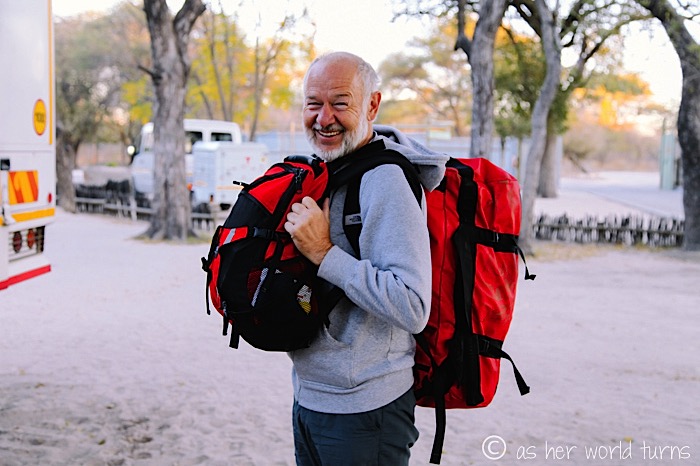
Early the next morning our group splits in two — the bush campers depart first in an open truck, and then the luxury campers will make their way to the airport to catch a flight into the Delta. We’ll all meet back here in two-and-a-half days.

Our ride into the Delta turns out to be an experience in itself — it’s way more fun in an open truck than an enclosed vehicle. We drive for maybe 90 minutes, the second half of which is through wetlands where at times we literally plow through two feet of water.

I should point out that there are no roads for this latter part of the journey. There are tire tracks which disappear at various water crossings, but there’s no signage or outward indication of where we are headed. Eventually we’ll reach the put-in spot for our camp and mekoro canoes will take us further into the Delta to our accommodation. At one point our driver stops, gets out, and walks around as though he’s not sure which way to go next. Then he gets back into the vehicle, reverses, and we split off in another direction. How incredible that he knows the area so well — landmarks of trees, sand bars, marshes — even as that terrain shifts year-round depending on the nuances of each flood cycle.
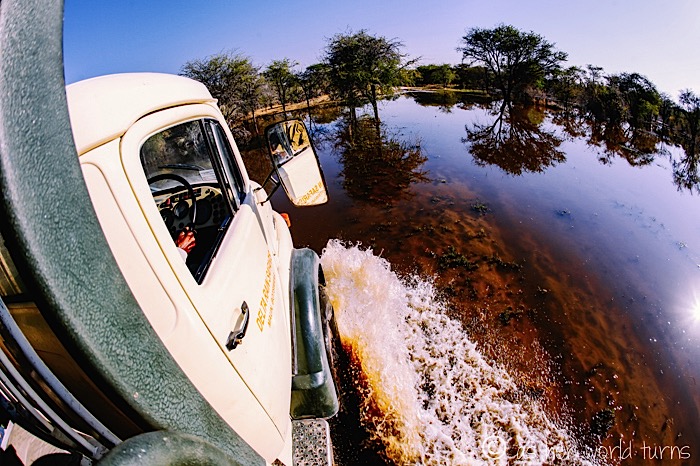
It’s all incredibly scenic. After getting enough shots, I remind myself to put the camera down and just enjoy the ride.


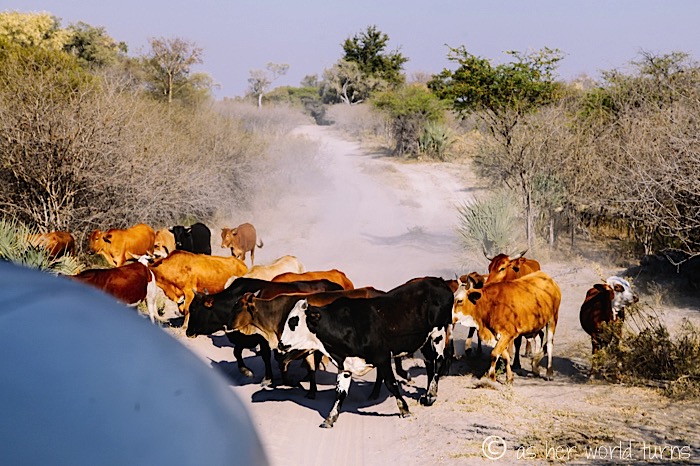
Eventually we reach the official drop-off area. Again, there are no signs, so we just pull over and wait. Maybe 15 minutes later several mekoros appear floating down the river towards us, propelled by the local polers standing at the rear of each craft with long wooden poles.

These polers are returning travelers who have spent the last two days at camp. They unload, we hop in with our bags, and off we go back towards our accommodation.
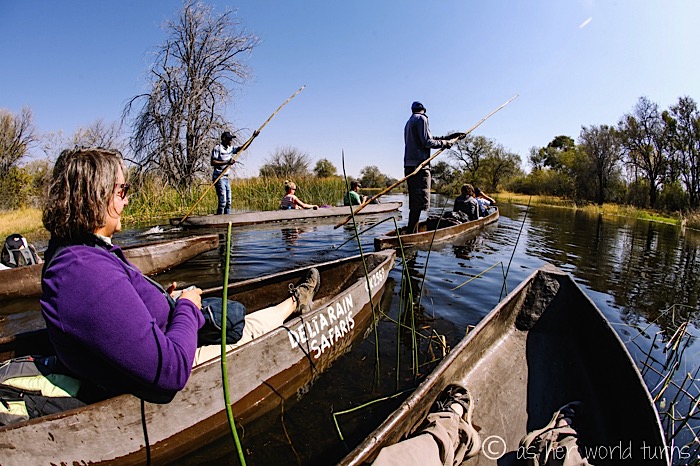
Traditional mekoros are dugout canoes carved from the trunk of a tree, but the ones we’re using are made of fiberglass. What is lost in authenticity is made up for in confidence; there are no leaks or cracks and unless our poler loses his balance (a genuine concern of mine that is quickly put to rest), we will not end up in the water.
Since I’m a solo traveler and everyone else is in pairs, I ride with our guide Soliwe. Our poler’s name is Amos and he thinks my name is Ericana. I don’t correct him. He calls me that for the next two days and I smile inwardly each time.
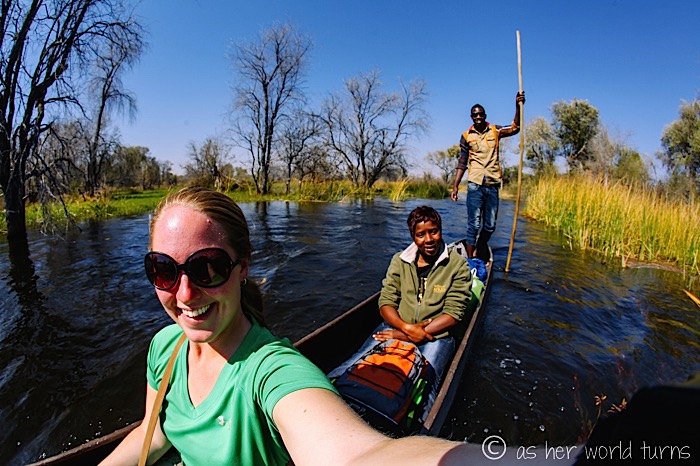
The water is enchanting. It’s only about two feet deep so the light hits the bottom in most places, revealing plants and lily pads and long grass swirling under the surface. Thank god our boat is so balanced and sturdy because otherwise I’d be nervous about taking out my camera, and it would kill me to miss photographing these details.

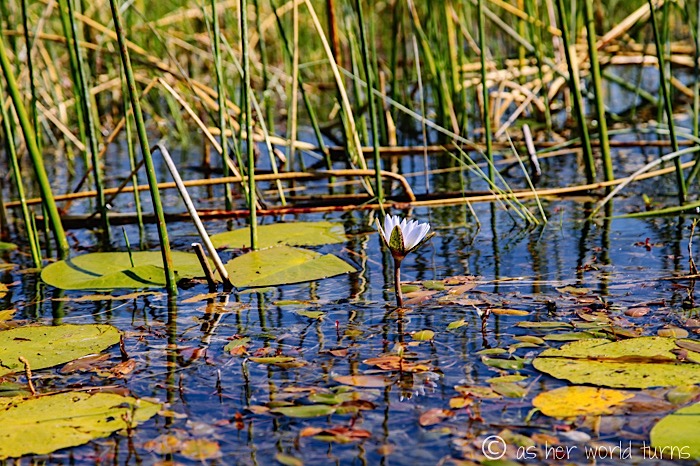

Here’s Soliwe and Amos, kindly putting up with my requests for photos:
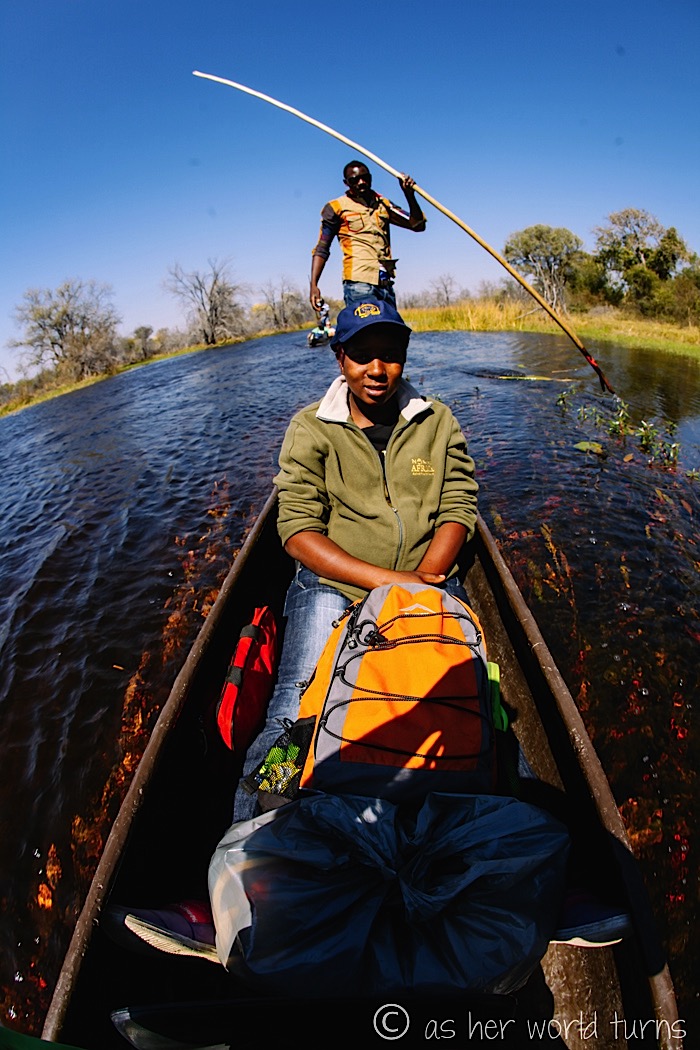
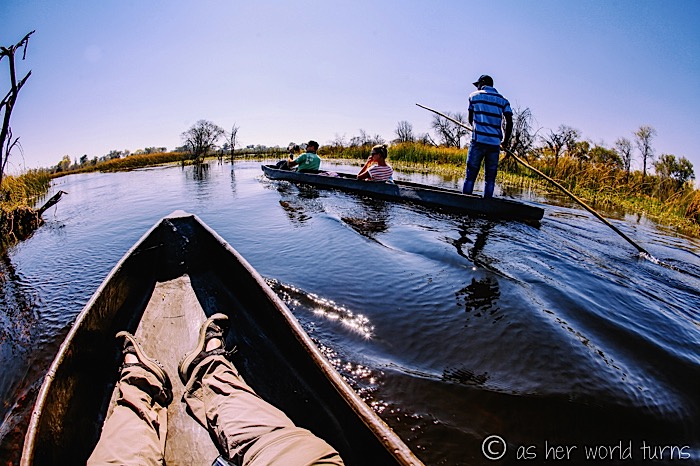


After around 45 minutes in the canoes, we spot camp in the distance.

During our mekoro ride, one of the polers made this necklace from a lily pad flower for my tour mate Tanya. We’ll get to practice making them during our afternoon swim time.

An elephant skull sits at the entrance to camp:

And so does this molted snake skin. Ewww…
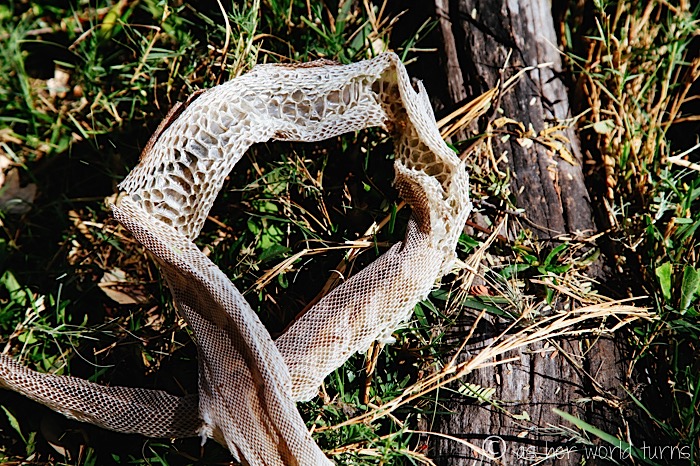
Our original plan was to stay at a bush camp, which means that the mekoro canoes would drop us off at a deserted stretch of land, we’d set up our own tents, bring all of our own cooking supplies (including a stovetop and dishes), and we’d have a shovel to bury human waste (a “toilet” area would be designated and if the shovel is gone that means the area is in use). When we pack up to leave the bush camp, there would be no sign of us ever having stayed there. That sort of ‘roughing it’ experience is what we all signed up — perhaps enthusiastically, perhaps begrudgingly — before the trip.
So imagine our surprise earlier that morning when guide Soliwe tells us that we’ve all been upgraded to a budget safari camp. It’s a new accommodation called Elephant Bush Camp that Nomad Tours is testing out to possibly use on future trips to the Delta. We get to be the guinea pigs who will sleep in real beds with rustic (but private) bathrooms … no digging toilet holes for us!
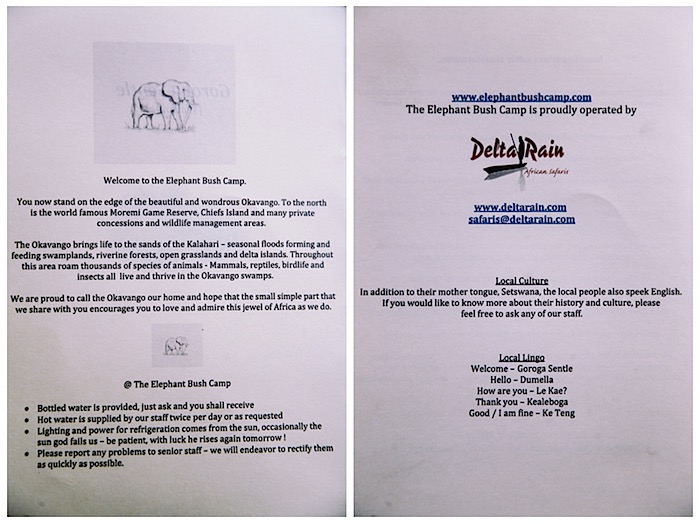
Here’s the outside of my tent — I get one all to myself!

And here’s the inside:
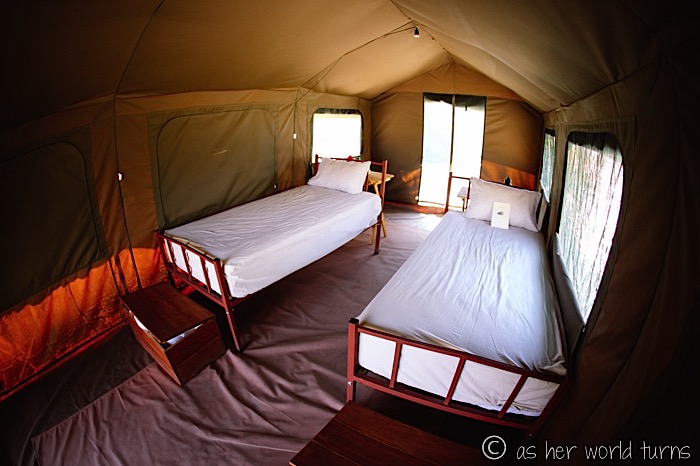
Directly behind the tent is my own bathroom area — a drop toilet and makeshift shower. In the evenings a staff member will fill the top bucket with hot water freshly boiled over the fire; I pull on the triangular handle to release the water, which drains out the back of the tent.
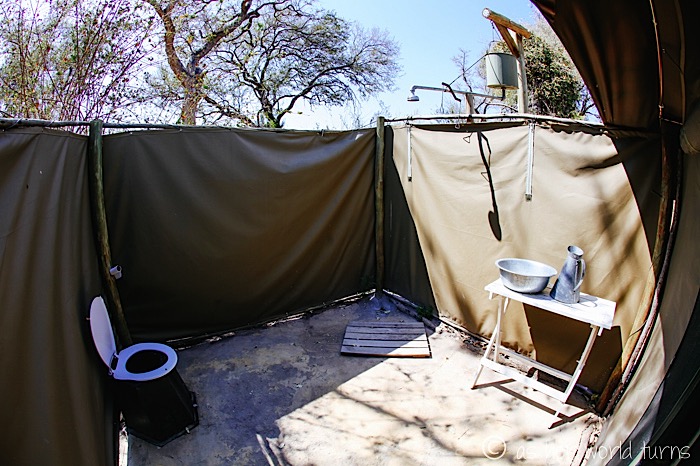
Here’s the view from the front of my tent:

Mekoros at the banks of our camp:
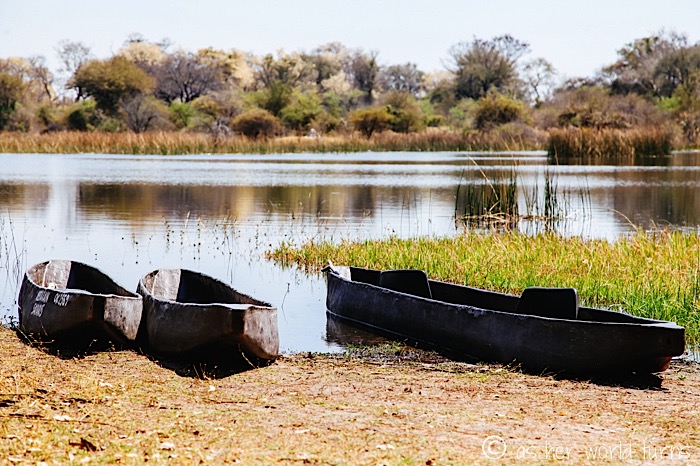
Soliwe puts together a hamburger lunch shortly after our arrival.
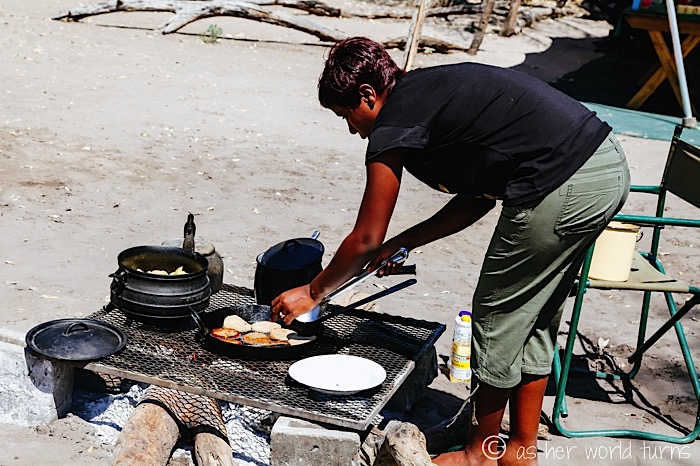
This is the view from our dining tent — not a bad place to enjoy a meal!
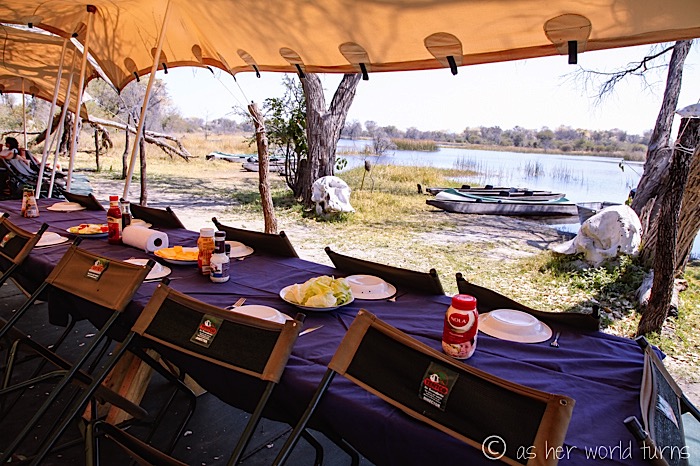
The afternoons at camp are oppressively hot. Our plan is to spend those hours resting and visiting a nearby swimming spot that is safe and devoid of wildlife (crocs, hippos, etc. are found in these parts). In the mornings and evenings, everyone will hop into the mekoro canoes to check out nearby walks for wildlife spotting. This is how we spend the next few days and it is blissfully relaxing — I can’t wait to share more over the next few posts.
I visited Botswana on a 30-day Nairobi to Joburg tour with Nomad Tours. They discounted my tour in exchange for blogging and photography; opinions are my own.

